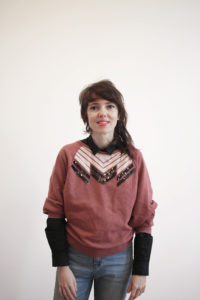Based in Geneva, Laura Couto Rosado is a co-founder and product/interaction designer at Digital Alchemy, a design school. She is also a teacher in the Master Media Design department at HEAD Geneva School of Art and Design. Right now, she is spending three months at CERN exploring the relationship between technology and design. She will be one of four speakers at the CERN panel.

What got you into the career you have now?
There are 3 parameters that have an ascendant on my career: my studies, the rewards and the belief in my work. I first studied for 5 years in a High School of Art and Product Design in South France. Then I graduated from the Master Media Design of HEAD-Geneva. The master program has allowed me to expand my skill-set as a designer and move towards the development of interactive products and smart objects. Shortly after my studies, I had the opportunity to win the Main Design Contests in Europe, which provided greater recognition and influence to my work and allowed networking in a professional network. This was the case for the CERN residency, which is a call for applications. Finally, what is important for me is to believe and trust my work and have an approach that is creating a strong symbiosis between design, science and technology.
As an artist, what are some of the connections to science you’ve discovered through design?
When you are at CERN, you realize that to make scientific discoveries of this magnitude, it is necessary to invent technologies to build largely scaled instruments that meet these ambitions. CERN’s particle accelerators require a huge amount of engineering and design work to be able to replicate the Big Bang conditions that created the Universe. The iconic formula of modern architect Louis Sullivan, “Form Follows Function,” becomes a favored way of designing these machines to strive towards universal truths. It is in this context of developing new technologies for particles physics research that I find similarities with design and that I connect to science.
How does science play a role in your personal process of designing?
Science plays a large role of inspiration in my practice. CERN is the most inspiring place I have ever seen in my life. I spent only 3 months of residency on site and I could sketch no less than 10 projects of different sizes that would give me work until 2037. I find this situation funny and dizzying at the same time. But after reflection, this is not so surprising because scientists plan and program their experimental research over the lifespan of their lives…that is to say 30, 40 years or more.
Is this your first time at SXSW? If so, what are you most excited for?
Yes, it’s my first time at SXSW. I am very curious and excited to attend a wide range of conferences on design and other fields. I am very excited to meet people who are interested in my work, expand my social network and export my signature to companies that have R & D clusters in niche technology product development. I’m also excited to discover and to learn more about Austin, its culture, customs and legendary BBQ.
What is the main focus of your panel?
My main focus is to explain fundamental science and its purpose. I will also talk about discovering more knowledge to understand how nature mysteries could affect, influence, and modify the creative process, and contribute to the research and the discoveries of new aesthetics and design practice.
What made you want to speak at SXSW?
I’m going to talk about the Quantum Nuggets project that’s going on that I put in place after the residency. Quantum Nuggets is a design process that consists of creating a vocabulary of printable and reproducible 3D generated shapes based on actual particle collision data from the CERN-built Large Hadron Collider (LHC). The current project is to develop parametric design objects that make the transition between our world and the quantum universe at the origin of the creation of matter and the universe. In the end, the objects produced must be capable of expressing a part of the intangible landscape of particles, governed by the mysterious laws of quantum physics.
What do you believe is the most important connection to be made between science and art?
I think the most important thing between science and art is having the privilege to learn the deep dialogue between these 2 domains and to strengthen them by setting up adequate platforms. This is the case at the program Arts at CERN lead by Monica Bello, for example. The platform will be used for the two domains to weave their connections. Thanks to the dialogue, we can highlight the permeability between the 2 areas that can give rise to important projects.
Sunday, March 11
5 p.m. – 6 p.m.
JW Marriot – Salon E/110 E 2nd St
Find out more: Decrypting the Universe: Science and Art at CERN
Featured image provided by Laura Couto Rosado
